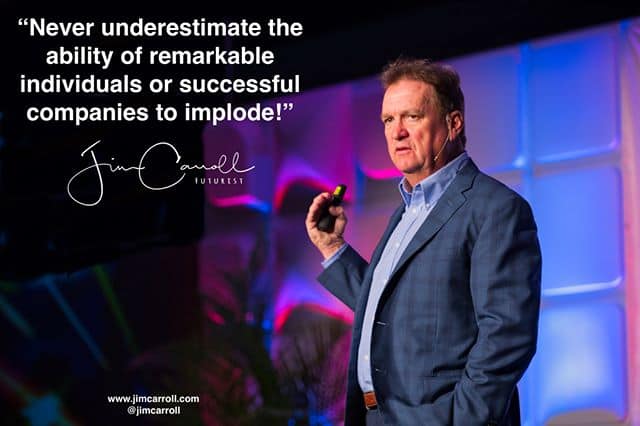It probably means that you are in pretty big trouble.

Over the last 25 years, I’ve been brought into an extensive number of Fortune 1000 leadership meetings at a senior level in order to speak about future trends an innovation – simply take a look at my client list to get a sense of who I work with. With this, I’ve seen many top-notch CEO’s who know that their organization needs to change – and fast. Often, I will be on the phone with them in advance of the event in order to understand their perspective on the challenges that are in front of them in the era of acceleration.
And on the other hand, I’ve seen situations involving the utmost of CEO hubris – a belief that the industry they are in, the business model they are structured for, and the customer behaviour they are aligned to, won’t be subjected to any sort of dramatic change. Which is, to put it mildly, foolish and dangerous!
Just about a year ago, I was in to talk to the senior leadership team of a major global company that I will leave nameless. There was a belief, expressed during a number of conference calls with various VP’s, that the organization needed to align itself for the challenges it might face in the era of Amazon business model disruption. The company is in essence, a distributor – a middleman between various manufacturers and the end customers. Amazon could step into and carve out some of the business; this is such a potential threat that numerous organizations engage me for my keynote on the challenge: Disrupting Amazon : Accelerating Strategies for Success in the Era of Industry Transformation.
And indeed, that was the topic for which I was booked!
Moments before I went on stage, the CEO spoke, immediately dismissing the idea that Amazon or other ‘upstarts’ might ever be a threat. Let’s just say it made for an interesting, if awkward, keynote. The folks who had booked me to come in with palpable with their discomfort.
I fully expect that as I watch this organizations from afar over the next 5 to 10 years – if not sooner — I will see Amazon and other new competitors begin to chip away at their business; I will witness scores of senior executives leave; I’ll see turmoil and havoc. And at some point, I’ll see the CEO depart the organization, mostly likely forced out by a Board that realizes far too late that hubris has no place in the world of fast-business today.
How does such hubris come about? Sadly, it’s easy.
- denial: a belief that things won’t change!
- avoidance of the issue : it’s easier to put off the potential threat than it is to make the tough structural moves to deal with the challenge
- aggressive indecision: a culture that sets up the top leadership team with a form of organizational sclerosis that holds them back from making difficult decisions
- the infallibility excuse: many senior executives believe that their business model, product line, or just about everything else won’t be at risk.
- the “I’m too smart” issue: simply put, the CEO knows better than anyone else!
- age and seniority: I always hate to drag up this issue, but I often find that a 65 year old CEO who encountered technology in the era of COBOL and punch cards simply isn’t equipped to deal with todays’ world of AI, IOT and disruptive change
It’s an extreme case where CEO hubris unfolds on stage – it’s only happened 2 or 3 times throughout my career.
Yet, I’ll often see this dread disease in action when I get an inquiry for an event. I’m often contacted by senior executives of global organizations who call to inquire about bringing me in for a critical senior leadership meeting. They’ve express to me that they need to deal with business model disruption; the impact of technology on their industry; the rapid emergence of new competitors; or other countless challenging issues; all the usual issues.
And then it goes to the CEO for approval, and word comes down — “it’s not the right time to do this.” To me, that is often a sign of arrogance, hubris, overconfidenceC
Hubris is deadly. To which I respond: Blockbuster. Radio Shack. Sears.




GET IN TOUCH
Jim's Facebook page
You'll find Jim's latest videos on Youtube
Mastodon. What's on Jim's mind? Check his feed!
LinkedIn - reach out to Jim for a professional connection!
Flickr! Get inspired! A massive archive of all of Jim's daily inspirational quotes!
Instagram - the home for Jim's motivational mind!